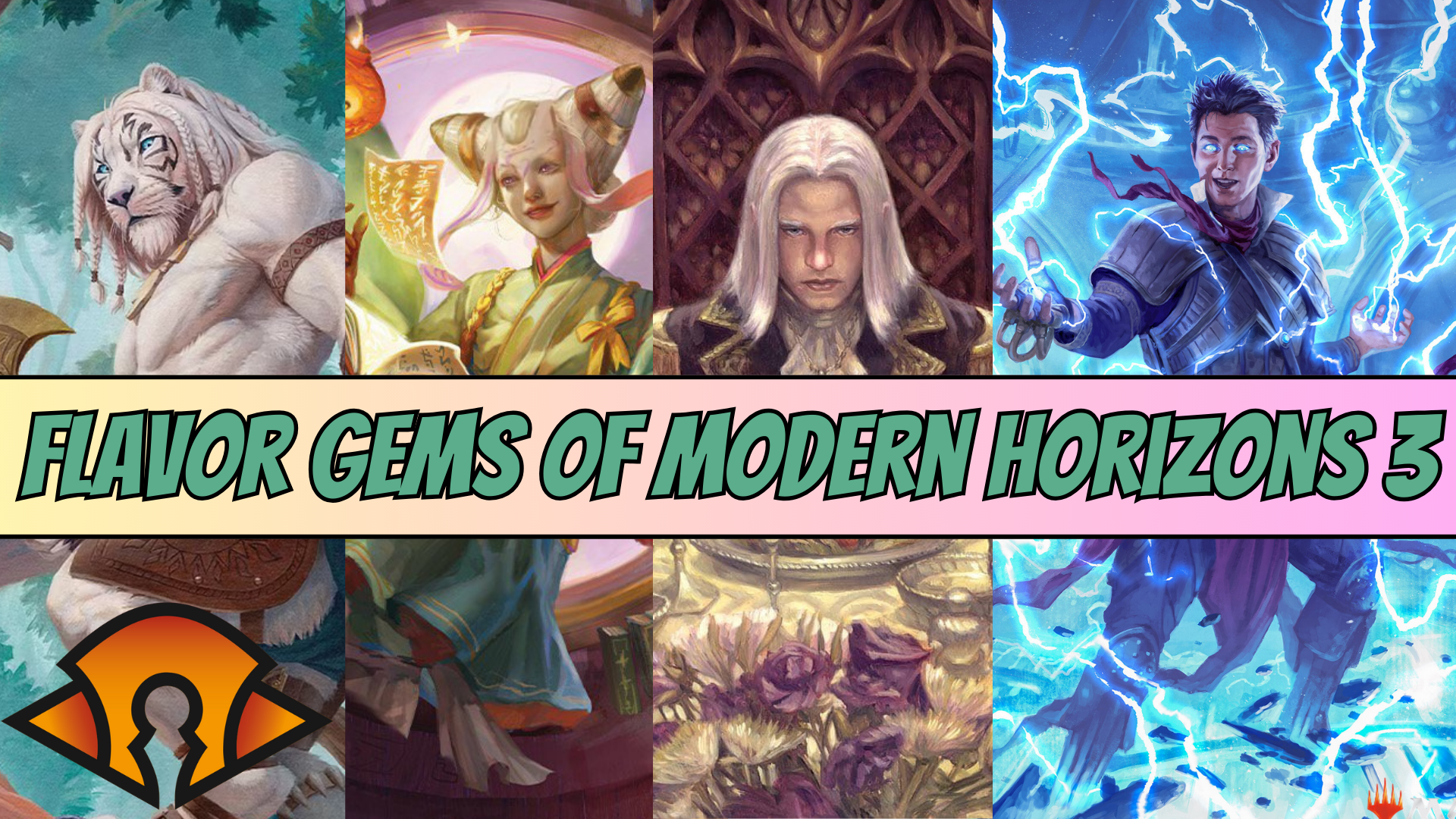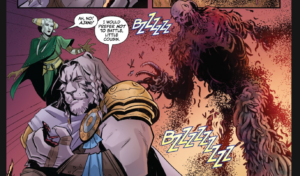The Flavor Gems of Modern Horizons 3

Ajani, Nacatl Pariah, Tamiyo, Inquisitive Student, Sorin of House Markov, Ral, Monsoon Mage
Ilse Gort | Evyn Fong | Matt Stewart | Borja Bindado
Flavor in Modern Horizons 3
Modern Horizons sets have everything a Commander player could want. Busted cards. Unique new strategies. Confusingly worded cards that would befuddle even AspiringSpike. My favorite part of these sets is their ability to make all of these deep cut references to Magic's history and lore. These releases aren't bound to a specific setting or place in time, so all of Magic is up for grabs! There's also an aim towards enfranchised players that encourages Wizards to dig deep for the most niche of niche subjects.
The first Modern Horizons set gave an example of the kinds of references we now come to expect. Iconic characters got represented in all the power on cards like Urza, Lord High Artificer
Modern Horizons 2 kept the hits coming. A focus on Dakkon Blackblade
But you didn't come here to listen to my Hogaak, Arisen Necropolis
The Return of Flipwalkers
Back in the olden days of 2015, Magic Origins released with a new spin on the formula of a core set. Rather than taking general ideas from the whole of Magic, the set focused on the origin stories of five iconic planeswalkers, represented by five legendary creatures that would transform into planeswalkers. These designs quickly became fan-favorites. Originally the design team had a lot more ideas for how to use flipwalkers, but the mechanic has only returned once with Nicol Bolas, the Ravager
For those unaware, certain creatures in Magic are born with a latent magical energy called a spark. Strong emotional stressors can ignite this spark, granting the individual the ability to walk the planes. The stories of these planeswalkers are represented in their cards. For example, take Ajani, Nacatl Pariah
With that in mind, look at Ajani's card. When he enters, he creates a 2/1 Cat Warrior creature token (Jazal). When another Cat dies (Jazal is killed in the raid), transform Ajani (his spark ignites). All of the flipwalkers here are mono-color legendary creatures that transform into enemy pair planeswalkers. Ajani is most commonly associated with Selesnya, but his Boros version hearkens back to Ajani Vengeant
All of the flipwalkers do a great job of encapsulating their character's stories. Well, we can assume they all do. Grist's is the odd-bug-out since she hasn't appeared in canon outside of Grist, the Hunger Tide

While we don't know exactly what ignited Grist's spark, her card might offer some clues. Her transformation triggers off of a creature entering from the battlefield. Since it seems like Grist is a kind of carrion insect, perhaps she consumed something that granted her the ability to planeswalker. My personal headcanon is that Grist ate the body of a recently deceased planeswalker, absorbing their spark before it could dissipate into the aether. That would explain why an insect, the type of creature who normally wouldn't have a spark, has one without an increased level of sentience. There's no canon explanation, so I guess we have to wait for a story to explain Grist's origins.
Please Roy Graham just let me try I promise I can cook I've worked with Rusty Quill this bug stuff is my jam
Big Lore Energy
Energy is a fan-favorite mechanic that first showed up in Kaladesh block, though its origins go all the way back to original Mirrodin. It was designed as a way to represent the residual power of artifacts, locking their abilities behind a new resource. It ended up getting scrapped in favor of much more broken designs, but R&D clearly loved it enough to bring it back for Kaladesh. Kaladesh is a world powered by aether, a magical essence that is part of the Blind Eternities. Aether is kind of like dark matter in our universe, except much more tangible to the denizens of certain planes.
Kaladesh is able to harness the aether due to its increased presence on the plane. The scientist Avaati Vya was able to capture the magical energy following the Great Aether Boom, an event in Kaladesh's recent past. Interestingly, this lines up with when the Mending occurred, causing some to believe the Aether Boom and the Mending are related. Since the event, Kaladesh has used devices like the Aetherflux Reservoir
Rather than thinking of aether as electricity harnessed by magic, it's more like magic harnessed by electricity. Aether is the strange cosmic gumbo that powers the multiverse. It exists within every spell, every spark, and every plane. Different cultures are able to manipulate it in different ways. Take Guide of Souls
By connecting aether to the connections between planes, this is a subtle gesture towards a long-brewing story point. Remember how the Mending was implied to cause the Aether Boom? It seems like this is a way of showing how aether manifests in response to major shifts in the multiverse's cosmology. With the Sylex's activation, the creation of the Omenpaths, and the Sundering of several sparks, the planes have been badly scarred. If damage to the multiverse causes aether to appear more often, we can imagine that aether is the equivalent of the universe's blood. And right now, it's bleeding badly.
Oops, All Eldrazi!
If Urza was the star of Modern Horizons and Dakkon Blackblade was the star of Modern Horizons 2, Emrakul and her compatriots are undoubtedly the focus of Modern Horizons 3. A massive portion of the set is filled with cards that are meant to make an Eldrazi Tron player blush. We've seen the Eldrazi in a handful of Magic sets over the years, but this set takes the opportunity to try weird designs that encapsulate the eldritch horrors of everyone's favorite spaghetti monsters.
The Eldrazi are meant to be cosmic horrors that are impossible to comprehend. A major example of this is seen in the devoid mechanic, used here on cards like Depth Defiler
Rather than existing as singular, three-dimensional beings as we understand the world, the Eldrazi occupy a kind of reality we cannot comprehend. Ugin describes this in Revelation at the Eye as a human reaching their hand into a pond
Imagine that you reach your hand into a pond. The fish below the surface sees a five-headed monster, and cannot perceive the man attached to it. It mistakes a hangnail for an eye because the truth is beyond its imagining.
When analyzing the Eldrazi as part of our reality, we cannot ascribe the same rules to them. The Titans have several aspects that play on our perception of them. For example, the new Ulalek, Fused Atrocity
Devoid represents that disconnect between perception and reality that the Eldrazi create. We see the world through the five colors of magic, creating structures that align with the mana we are made of. As shown in the popular Magic story Loran's Smile, the colors of mana serve as the fundamental laws of reality. Red mana can do certain things that blue mana can't, and vice versa. The ability to harness mana and interpret it dictates what something can do. The Eldrazi might resemble these constructs, but they are part of something far beyond the five colors. Spawn-Gang Commander
Widening Your Horizons
Those are the major lore tidbits that Modern Horizons 3 focuses on! A lot of this is extrapolation from various sources, so don't go citing this on the MTG Wiki. This set is by no means the peak of esoteric Magic lore. There's plenty more to be discovered with just a bit of digging. Below, I've included links to some articles that might peek your interest if you want to learn more about Magic lore. There's a rich multiverse of strange worlds, powerful creatures, and captivating stories to be discovered. So don't wait! Go and ignite your lore-loving spark.
Want to Learn the Lore?
Retrospective Reviews: Garruk Wildspeaker by Ciel Collins
The Lost Caverns of Ixalan: Cultural and Historical References by Jessica Sagahon
Flavor of the Month: Grilled Ramps with Chandra and Nissa by Brandon Amico
Welcome to Flavortown: Venser, Corpse Puppet by Jubilee Finnegan hey that's me!